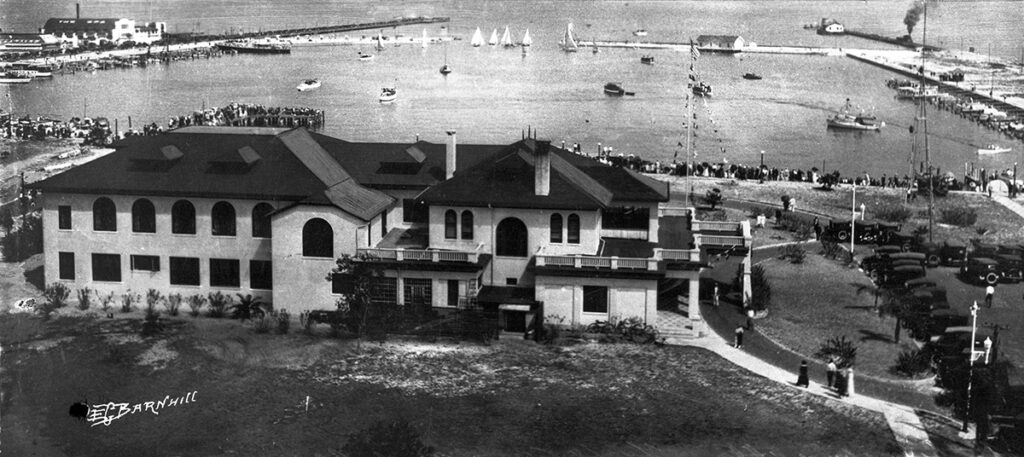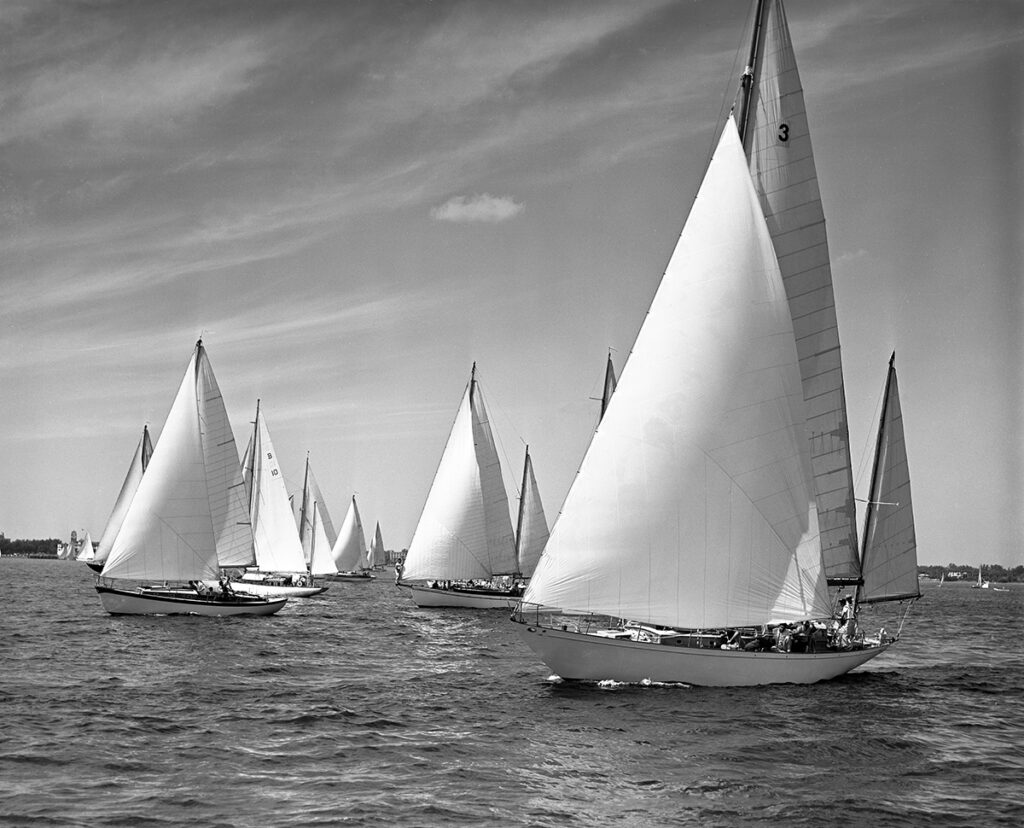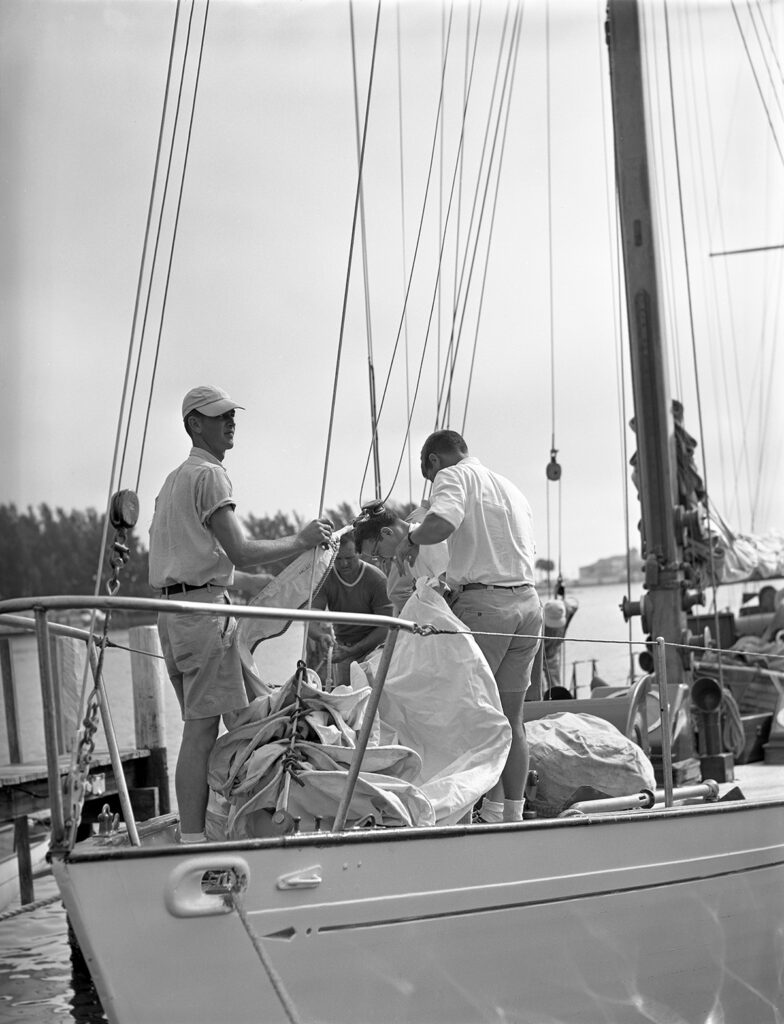In 1903, popular wisdom viewed port-centered industrialization as the key to prosperity for coastal communities. In St. Pete, however, some city boosters imagined a different path. These visionaries pictured a waterfront park system and yacht basins instead of “a hodgepodge of buildings, commercial wharfs and derelict boats.” The notion that a community would forgo industry in order to protect “the natural and recreational amenities of the city” was controversial at the time and the process was lengthy, but in September 1910 this imagined waterfront park became a reality.

A Yacht Club is Born
Nearly one year before the park’s launch, another was under way. Determined that the transforming waterfront would have “a yacht club as its centerpiece,” local boosters, including William Straub and Perry Snell, organized a yacht club. A few events were held over the next five years, but the club was energized by the completion of the new Central Yacht Basin. Incorporating as the St. Petersburg Yacht Club (SPYC) in 1916, they opened their newly built clubhouse on June 15, 1917, “with an informal celebration” for 200 members and guests. Less than five years later, the hurricane of 1921 badly damaged that “handsome new structure.” In spite of that, times were good during St. Pete’s boom years, and membership rose quickly, as did funding. Just over a year after the storm, the repaired and newly expanded clubhouse reopened in December 1922, with a “Great Reception” for 600 attendees. The SPYC thrived during the early 1920s, but the local land speculation crash in 1926 and the onset of the Great Depression hit the club hard. From hardship, an idea for a race emerged.

Gidge Gandy Sails to Cuba, and a Race is Born
In 1930, the port city of Havana was the bustling, vibrant capital of Cuba. Dubbed the “Paris of the Caribbean,” Havana’s free-flowing rum, extensive gambling, exotic nightlife, and beautiful location had made it a magnet for moneyed tourists and investors of all kinds. George “Gidge” Gandy Jr. was among them. Son of the man who spanned the bay with the Gandy Bridge, he was an avid yachtsman. He had sailed his two-masted sailboat “Cynosure” to Havana, and he saw an opportunity to boost the SPYC. In partnership with the Havana Yacht Club, a race was born. On Saturday, March 30, 1930, 11 yachts set out from St. Petersburg for the 284-mile race to Havana. The “thundering roar” of a small cannon signaled the start as “a crowd estimated at 2,000 persons gathered on the Municipal pierhead, waved flags and handkerchiefs and bid them ‘bon voyage.’ ” The competition was advertised as a “fitting culmination” of the annual Festival of States celebration. The festival queen and the president of Cuba were on hand to greet the racers when they arrived at Morro Castle in Havana on Monday. Hailed as a local success, this “sailing epic” also received international acclaim.
“A Good Race”
In the months after the race, at least three well-regarded publications praised the race, including The Rudder, Yachting, and The Sportsman. Lauding the course and its planners in a May 1930 editorial, The Rudder: The Magazine for Yachtsmen noted that the St. Petersburg-Havana Race “is just long enough to make it interesting and to impose no great hardships on the boats and crews under ordinary conditions.” They concluded: It “will long-remain as one of the outstanding ocean race events of the present year.” Celebrating its 40th year as the preeminent yachting journal, The Rudder also included a photo spread of the various entries and a detailed account of the race. With obvious Southern pride, the writer of the latter capped his account with a bit of a dare: “If northern yachtsmen had equal sporting spirit, there would be over one hundred starters in every northern ocean race. Put that in that in your pipes and smoke it, you Yankees!”
The Race Goes On

With its success proven, the race became an annual and increasingly prestigious event. It began to draw “the best ocean racing yachts from the US Eastern and Gulf coasts, the Great Lakes and Cuba.” In 1935, the race attracted “the largest list of entries in the history of the international event.” A crowd of 25,000 watched the boats depart. Its popularity continued over the next two decades. Sailors raced the same 284-nautical-mile course between 1930 and 1957, with the exception of the World War II years. In 1958, Cuba’s political unrest led to a diversion to Miami, but in 1959, the race returned to its original path. Followers were effusive in their praise. As a St. Petersburg Times sports editor noted, “When Gidge Gandy and Cuba’s Rafael Posso hoisted a cool one in Havana in 1930 and made modest plans for the first St. Petersburg-Habana race…they envisioned a fun and salty adventure, they probably never dreamed the stature their event would one day attain. …” Nonetheless, the culmination of the Cuban Revolution in that same year signaled the end of the race in the 20th century. It was briefly revived from 2017-2019, but the future of the race is uncertain. In the meantime, fans can always “hoist a cool one” in memory of the “Good Race.”



